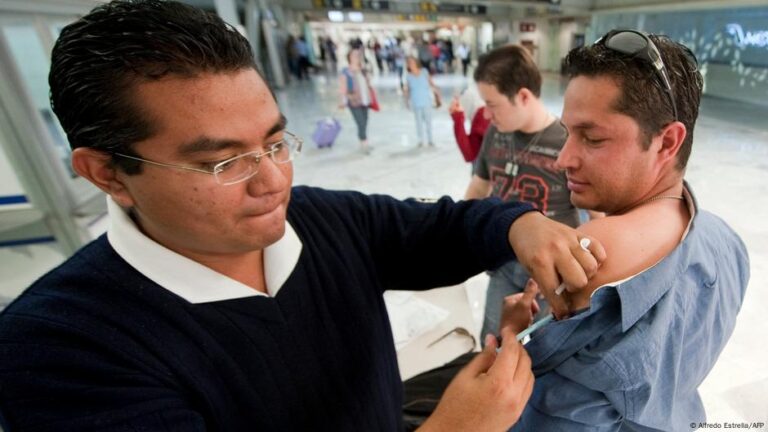Measles is well-suited for eradication. The virus only spreads among humans and does not survive long in the environment.
There’s a vaccine and it is cheap and effective. And if enough people (95% of a population) get immunized, the deadly disease could be gone forever.
By the year 2000, 82 countries had eliminated measles within their borders, including the US. But measles is making a comeback — outbreaks are happening in every region of the world.
Yemen saw over 10,000 cases in April 2025. And India had over 7,000 cases — measles is the number one cause of death from disease among children there.
Meanwhile, the US is experiencing one of its worst measles outbreaks in decades. The virus has also crossed into neighboring Mexico and Canada. A total of 2,500 cases and four deaths have been reported across the three countries since the start of 2025.
In Europe, measles is on the rise as well — cases here doubled between 2023 and 2024. They are at their highest rates since 1997, with 127,350 cases reported in 2024.
Why is measles spreading again?
Measles is spreading because fewer people are getting vaccinated.
In 2024, 87% of measles cases were diagnosed in unvaccinated people, according to an analysis by the European Centre for Disease Prevention and Control (ECDC).
“Measles is back, and it’s a wake-up call,” said Hans Kluge, WHO regional director for Europe, in a statement.
“Without high vaccination rates, there is no health security. Every country must step up efforts to reach under-vaccinated communities,” said Kluge.
Herd immunity needs 95% immunization rates
Measles is an airborne disease caused by the measles virus. Its symptoms include rashes and high fevers that are extremely dangerous for small children.
But measles is preventable through vaccination. Two doses of a measles vaccine, such as the MMR (measles, mumps, and rubella) vaccine, provide more than 99% protection against infection and transmission.
The World Health Organization (WHO) estimates that immunization efforts averted 60 million deaths globally between 2000 and 2023.
Controlling the disease requires a vaccine uptake “higher than 95% — the herd immunity threshold,” said Michael Head, an epidemiologist at University of Southampton.
Herd immunity is when enough people in a community become immune to a disease that infections can’t spread, and people who are unable to be immunized are protected as a result.
“[But] as we have seen in recent years, this is very difficult to achieve globally,” said Helen Bedford, an expert in child health and immunization at University College London.
It’s difficult because measles is one of the most infectious viral diseases on the planet. It can spread between people more easily than the most infectious variants of SARS-CoV-2, the virus that causes COVID-19.
“If one person has it, 90% of susceptible people in close contact become infected,” said Bedford.
Measles vaccine uptake is falling
Analysis from the ECDC shows routine childhood vaccination against measles remains below the recommended level to eliminate measles in many European countries.
Only four European countries reached the ≥95% threshold for a second required dose of measles-containing vaccine in 2024.
Measles can easily cross borders and cause outbreaks in a community where people are unvaccinated or under-vaccinated. And even if overall vaccine uptake is high, measles outbreaks can occur in communities where uptake is lower.
“We no longer have herd immunity to measles in many countries,” said Bedford.
Anti-vaccine campaigns ‘cost lives’
Health experts say misinformation campaigns are among the main driving forces behind lower vaccine uptake.
One, well-documented case involved former British general practitioner Andrew Wakefield and colleagues in the late 1990s and early 2000s.
They published a series of cases in The Lancet medical journal, suggesting that the MMR vaccine predisposed children to “behavioral regression and pervasive developmental disorder,” and may trigger autism. Their claims were quickly scientifically debunked.
But “when Wakefield fabricated the link to autism, [it] caused a drop in confidence in the MMR vaccine,” Head said.
In the UK, where Wakefield was based, his claims led to an 8% decline in children receiving the MMR vaccine by 2002. In the US, vaccinations dropped by 2% in 1999 and 2000, also attributed to Wakefield’s claims.
Because herd immunity requires 95% of people to be immunized, even small drops in vaccine uptake can allow measles to spread. This creates pools of susceptible young adults who may be vulnerable when outbreaks occur.
Although scientists thoroughly disproved Wakefield’s MMR-autism link, the drop in vaccination rates persisted.
“And now in 2025, we have [US Health Secretary] Robert F. Kennedy repeating these untruths. Misinformation causes harm, and costs lives,” said Head.
Never too late: measles can still be eradicated
Anti-vaccine campaigns aren’t the only reason behind falling immunization rates. Immunization coverage for many infectious diseases, including polio, Hepatitis B, and measles, declined during the COVID-19 pandemic.
“Uptake of routine vaccines declined globally during the pandemic because of pressures on health services and people being unaware that routine vaccines were still being offered,” said Bedford.
In addition, people living in socially deprived areas often lack easy access to healthcare centers, where vaccines are administered.
A study published in April 2025 found that a measles outbreak in Birmingham, UK, had disproportionally affected socially marginalized communities and some ethnic minority groups in which vaccine uptake was low.
“Quite simply, improve vaccine uptake, and once improved, sustain high uptake. It’s never too late to be vaccinated, even as an adult when measles is often a more severe disease,” said Bedford, adding that measles immunization programs needed political commitment and financial investment.
Edited by: Zulfikar Abbany
Select sources:
Measles: Annual Epidemiological Report for 2024, European Centre for Disease Prevention and Control https://www.ecdc.europa.eu/sites/default/files/documents/MEAS-AER-2024-Report.pdf
Sociodemographic inequalities in the epidemiology and vaccine uptake within a large outbreak of measles in Birmingham, England, 2023 to 2024. Published in Eurosurveillance, April 2025 https://www.eurosurveillance.org/content/10.2807/1560-7917.ES.2025.30.16.2400652


